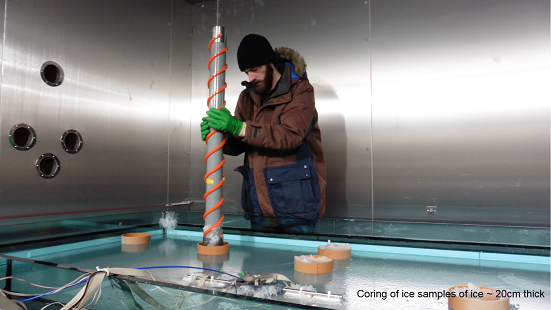Sea ice formation temperature controlled facility

Working on sea-ice is incredibly challenging, expensive and at times a little dangerous… it’s an incredibly complex environment, no controls on experimental conditions and difficult to gain access.
A laboratory environment removes quite a few of these barriers… The UEA sea-ice chamber, named in honour of the late Roland von Glasow as the Roland von Glasow air-sea-ice chamber (The RvG ASIC), aims to be a little different from previously constructed sea-ice chambers. It has an enclosed ocean-sea-ice-atmosphere system which can be temperature controlled and each of the ocean, sea-ice and atmosphere continuously monitored and sampled from.
The sea-ice tank measures 2.4m x 1.4m x 1m deep, with an optional transparent Teflon atmosphere of the same size can be attached above. Temperature can be controlled from +30°C to -55°C, and sea-ice can be grown to a maximum thickness of ~30cm.Lighting is provided by solar replication LED’s and UV through a combination of broadband florescent UVA and UVB bulbs.
Remote access to the facility is possible, so you can monitor experiments and change some parameters without even having to be in the same country…
Instrument Suite.
The following range of equipment is available permanently in the RvG ASIC, and provisions can be made for scientists to bring their own sensors / measurement systems too.
For ease of experiment design, the equipment / measurement possibilities are sectioned by ocean, sea-ice and atmosphere.
“Ocean” instrumentation:
MicroCAT CTD (conductivity, temperature and depth) sensor deployed
Two further micro CTD sensors deployable at any location in the ocean section
Mechanical and UV filtration system, capable of overturning the water every 2 hours.
Controllable aquarium circulation pumps and wave generator.
Underwater camera system (with LED light)
Sea-ice temperature chains can also be extended into the ocean.
Sea-Ice instrumentation:
In-ice pressure (2cm resolution)
In-ice temperature chains (1-4cm resolution)
In-ice UV-Vis light transmission (3cm resolution)
In-ice salinity* (derived from resistance) and solid fraction profiles (1cm resolution)
Post ice tools available include:
coring and sectioning the sea-ice.
UV-vis absorbance (liquid phase)
Bulk salinity
Other standard liquid phase analytical measurements in house at UEA.
“Atmosphere” instrumentation
Field deployable met station, with humidity and precipitation
Suite of 6 PT-100 temperature probes for measuring the air temperature around the chamber
2π Spectroradiometer, measures incoming UV-Vis radiation and converts to photolysis frequencies in near real time.
Atmospheric gas measurements:
NO, NO2, NOy, O3 by Teledyne chemiluminescence instruments
CH4, CO2 and water vapour by LGR Greenhouse Gas Analyser